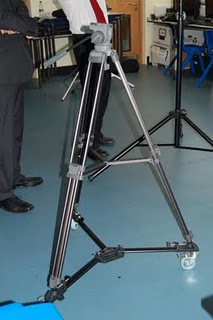Last Friday we managed to get a look at all the equipment the department has for us to use in our production for Music Videos.
1.Cameras
The media department manage to get a good amount of funding so we're lucky enough to have roughly 5 different cameras to choose from :)
Firstly we have your average hand-held digital camera this is very basic and produces very low quality footage as its not very proffessional. The sound and visuals are both of a low quality as the microphone is quite small and the lense doesn't really pick-up on every aspect of 'light', this means that footage produced will look very grainy and unclear.
Next we have the Cannon 550D its small and therefore easily transported but not so small that you can lose it. Its good for changing the depth of field of a shot or even trying to capture a shallow focus shot. By using this camera it is very easy for one to imagine each shot as a single photograph as it IS primarily a camera not a video camera
The Cannon XM2 is one of the more proffessional cameras as it can be used in low key lighting situations and still produce excellent quality footage and the large microphone also ensures that all sound is picked up. Not to mention that the camera shoots in HD so footage quality will be just that more better.
2.Lighting
Fill Lights are extremely bright and strong and are similar to the kinds of lights you would find at a concert,lighting up the stage. These need to be used with a bit of caution because you wouldn't want your actors/tresses going blind.You can also use these to change the background colour by covering them with coloured gel sheets.
The second type of light we have is more commonly known as the spotlight. It's main aim is to highlight the artist/model in question. It can also change the colour of a room/area using coloured gel sheets.
3.Other
Camera Support
There are two types of Tripods, the first of which is a standard Tripod, it can be adjusted to fit the level of shot needed and is portable making it easy to carry around.However it is stationary and therefore cannot be used for tracking shots.
This is a Dolly Tripod, its ideal for Dolly/Tracking shots where its difficult to carry a camera and keep it steady.The Tripod can simply be pushed along, having said that the Dolly Tripod works best on smooth surfaces as uneven surfaces may create uneccesary background noise.
The crane is very good for overhead shits where you want a downward tilt on your actors/models/artists. The hight of the crane can be easily adjusted and is easy to use.
The Autocue is useful when shooting with dialogue and is most commonly used by News Channels so that the presenter can keep looking at the audience whilst speaking, maintaining eye-contact and holding their audience's interest.
The last item in this list is used alongside Cameras, The Visual Switcher enables one to link a number of Cameras to the device so that during a production you can switch to different views of the same shot. This is mostly used in Live productions on TV however in Music videos this is useful as you can form your narrative based on the different shots you see on the screen of the Switcher.


